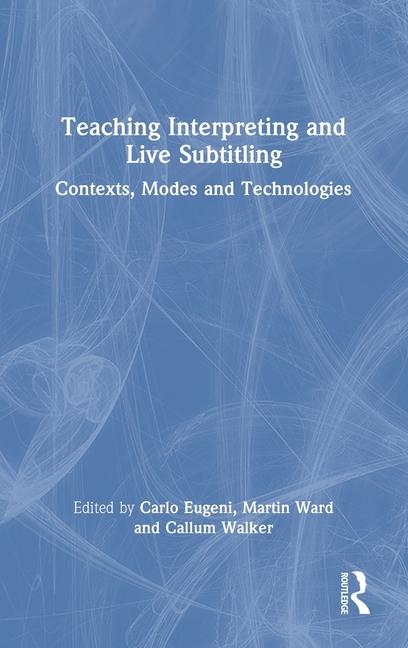Bücher versandkostenfrei*100 Tage RückgaberechtAbholung in der Wunschfiliale

Zustellung: Sa, 19.04. - Fr, 25.04.
Versand in 2 Wochen
VersandkostenfreiBestellen & in Filiale abholen:
Teaching Interpreting and Live Subtitling: Contexts, Modes and Technologies provides a cross-section of multi-national perspectives on teaching various dimensions of interpreting and live subtitling, both within dedicated programmes and as part of individual modules on interpreting and/or live subtitling-adjacent programmes.
Inhaltsverzeichnis
List of contributors
1. Introduction
Carlo Eugeni
Part I. Interpreting training and the classroom
2. Challenges in conference interpreting training: how to bridge the gap between academia and the professional booth?
Fanny Chouc
3. The Importance of vision in interpreter training
Jenny Wong
4. Does an implicit learning environment always lead to successful interpreter training? Students' procedural learning abilities and interpreting skill types can have the con
Yinghua Wang
Part II. Interpreting training and the profession
5. An Experimental study on interpreters' experience of RSI: Implications for post-pandemic research and practice
Clarissa Guarini
6. Interpreting for minors in legal encounters in Ireland during the COVID-19 pandemic: patterns of practice and implications
Eddie Ló pez-Pelé n
7. The Importance of implementing higher education training opportunities for interpreters in schools
Letizia Leonardi
Part III. Live subtitling training, the classroom and the profession
8. Redefining respeakers' training: A Practical approach to diamesic translation tactics and respeaking skills
Martina A. Bruno
9. Reaching MARS: How to increase speed and accuracy in formal and informal training in live subtitling
Carlo Eugeni and Alessio Popoli
10. Intralingual and interlingual respeaking didactics: redefining human-machine interaction challenges into opportunities
Alice Pagano
11. Teaching live subtitling through mock conferences
Faruk Mardan
12. Professional training in Valencian live subtitling: navigating diglossia and language variation
Luz Belenguer Corté s
Index
1. Introduction
Carlo Eugeni
Part I. Interpreting training and the classroom
2. Challenges in conference interpreting training: how to bridge the gap between academia and the professional booth?
Fanny Chouc
3. The Importance of vision in interpreter training
Jenny Wong
4. Does an implicit learning environment always lead to successful interpreter training? Students' procedural learning abilities and interpreting skill types can have the con
Yinghua Wang
Part II. Interpreting training and the profession
5. An Experimental study on interpreters' experience of RSI: Implications for post-pandemic research and practice
Clarissa Guarini
6. Interpreting for minors in legal encounters in Ireland during the COVID-19 pandemic: patterns of practice and implications
Eddie Ló pez-Pelé n
7. The Importance of implementing higher education training opportunities for interpreters in schools
Letizia Leonardi
Part III. Live subtitling training, the classroom and the profession
8. Redefining respeakers' training: A Practical approach to diamesic translation tactics and respeaking skills
Martina A. Bruno
9. Reaching MARS: How to increase speed and accuracy in formal and informal training in live subtitling
Carlo Eugeni and Alessio Popoli
10. Intralingual and interlingual respeaking didactics: redefining human-machine interaction challenges into opportunities
Alice Pagano
11. Teaching live subtitling through mock conferences
Faruk Mardan
12. Professional training in Valencian live subtitling: navigating diglossia and language variation
Luz Belenguer Corté s
Index
Produktdetails
Erscheinungsdatum
16. Dezember 2024
Sprache
englisch
Seitenanzahl
188
Herausgegeben von
Callum Walker, Carlo Eugeni, Martin Ward
Verlag/Hersteller
Produktart
gebunden
Gewicht
463 g
Größe (L/B/H)
234/156/13 mm
ISBN
9781032577883
Entdecken Sie mehr
Bewertungen
0 Bewertungen
Es wurden noch keine Bewertungen abgegeben. Schreiben Sie die erste Bewertung zu "Teaching Interpreting and Live Subtitling" und helfen Sie damit anderen bei der Kaufentscheidung.








